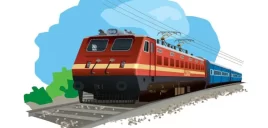Mixed-gauge tracks do exist in several places in India, although with the ongoing ‘Unigauge’ project that is progressing at a frenetic pace, there are not as many now as there used to be earlier. A complete list would be hard to compose. Mostly, mixed-gauge tracks exist(ed) in areas where it is/was difficult to have multiple tracks (built-up areas, difficult terrain, bridges/tunnels) and where there is/was a strong need to have stock of different gauges reach the same place (i.e., near ports, inter-modal shipment points, etc.).
Dual-gauge BG/MG tracks exist between Ponmalai (Golden Rock) and Thiruverumbur (which has a BHEL plant) which allows both BG and MG locos to reach the Golden Rock loco workshop (this runs parallel to the Thanjavur MG line for a few km). Sarupsar-Suratgarh (21.5km) (NR, Bikaner division) is another BG/MG dual-gauge section; the BG part connects Suratgarh with Anupgarh, while the MG part connects Suratgarh to Sriganganagar.
The BG line from Arakkonam shares the a rail with the MG track for a short while just near Chengalpattu. The Madras Beach to Royapuram section was [4/01] dual-gauge with 3 BG rails allowing both BG and MG traffic. MG petrol tankers used this route to reach the port area. However, this dual gauge track has been dismantled completely following the Egmore – Beach gauge conversion.
Ahmedabad Jn. has [1997] some dual-gauge BG/MG tracks, with a couple of platforms that are used by both MG and BG trains. About 5km of track between Mysore station and the Ashokapuram railway workshops on the Mysore-Chamarajapuram line are of mixed gauge, to allow BG rolling stock to be sent to the workshops and for commercial MG services. (One or two platforms at Mysore have mixed gauge tracks.)
The Motibagh Workshop and Motibagh Yard at Nagpur has a bit of Mixed Gauge BG/NG track leading to the workshops to enable both BG/NG locos and rolling stock to reach the workshop.
A bridge over the Adjai river near Katwa has BG and NG (2’6″) tracks running interlaced (not gauntleted, i.e., the NG tracks are not completely within the BG tracks; instead one rail of the NG track is inside the BG tracks and the other is outside.
Up till the 1970s, the Nagpur-Itwari section had NG track embedded within a BG track to allow both BG and NG traffic to move on the same section. It now has separate BG and NG tracks side by side. And as late as the early 1990s, Mangalore station had a platform shared by MG and BG trains, with the MG track embedded within the BG track.
The Madras Port Trust Railway used to have a large dual-gauge operation in the late 1950’s — all harbour tracks were dual-gauge BG/MG. The shunting locos had BG couplers as well as offset MG chopper (NCDA) couplers. BG wagons were held at the north (Royapuram) end of the yard and MG wagons at the south (Madras Beach) end. Mixed gauge BG/MG track ran between Korukkupet station yard (with an Indian Oil depot) to Chennai Beach, passing through Washermanpet and Royapuram. It was also electrified, making it perhaps the only such mixed gauge track under the wires. Even today [5/05] small sections of mixed gauge track can be seen in the Chennai area, especially near crossovers, e.g., at Chengalpattu, Villupuram, etc.
Other sections that used to be mixed-gauge: Managalore-Kankanadi (4.5km), Coimbatore – Coimbatore North (2.7km), Palghat – Palghat Town, (3.9km, BG/MG), Tambarapani Block Hut – Thirunelveli (1.4km), Salem – Salem Market (2.6km), Barauni – Bachwara (16.10 km), Brahmaputra bridge before Guwahati (all BG/MG dual gauge); the Mahananda river bridge between Siliguri Town and Siliguri Junction, and Bhandra Bridge No. 50 near Bhadravati in the Birur-Talguppa section (0.5km) for MG / 2’0 NG dual-gauge. MG track embedded within BG existed between Varanasi and Varanasi City when Aunrihar-Chhapra was a MG route; similar trackwork also existed between Panambur Port and Mangalore.
The Serai Sugar Works in Uttar Pradesh has mixed gauge track (MG and 2’6″ NG), which was (still is??) used for a mixed gauge train: the locomotive Tweed, an 0-4-0 steam loco dating to 1873 (see the item on old steam locos) is an MG locomotive, but it hauled a rake of 2’6″ NG freight wagons carrying sugarcane.
On the subject of mixed gauges, IR has only rarely had any rolling stock capable of running on more than one gauge. Some official saloons and some of the saloons used by royalty from the princely states did have provisions for being attached to wheelsets of different gauges. One such example is the Maharani’s Saloon preserved at the Mysore Railway Museum which ran on both BG and MG.
Source – IFRCA.org
Disclaimer: The Information /News /Video provided in this Platform has been collected from different sources. We Believe that “Knowledge Is Power” and our aim is to create general awareness among people and make them powerful through easily accessible Information. NOTE: We do not take any responsibility of authenticity of Information/News/Videos.
This entry was posted in 2 Railway Employee, STUDY NEW, Railway Employee











